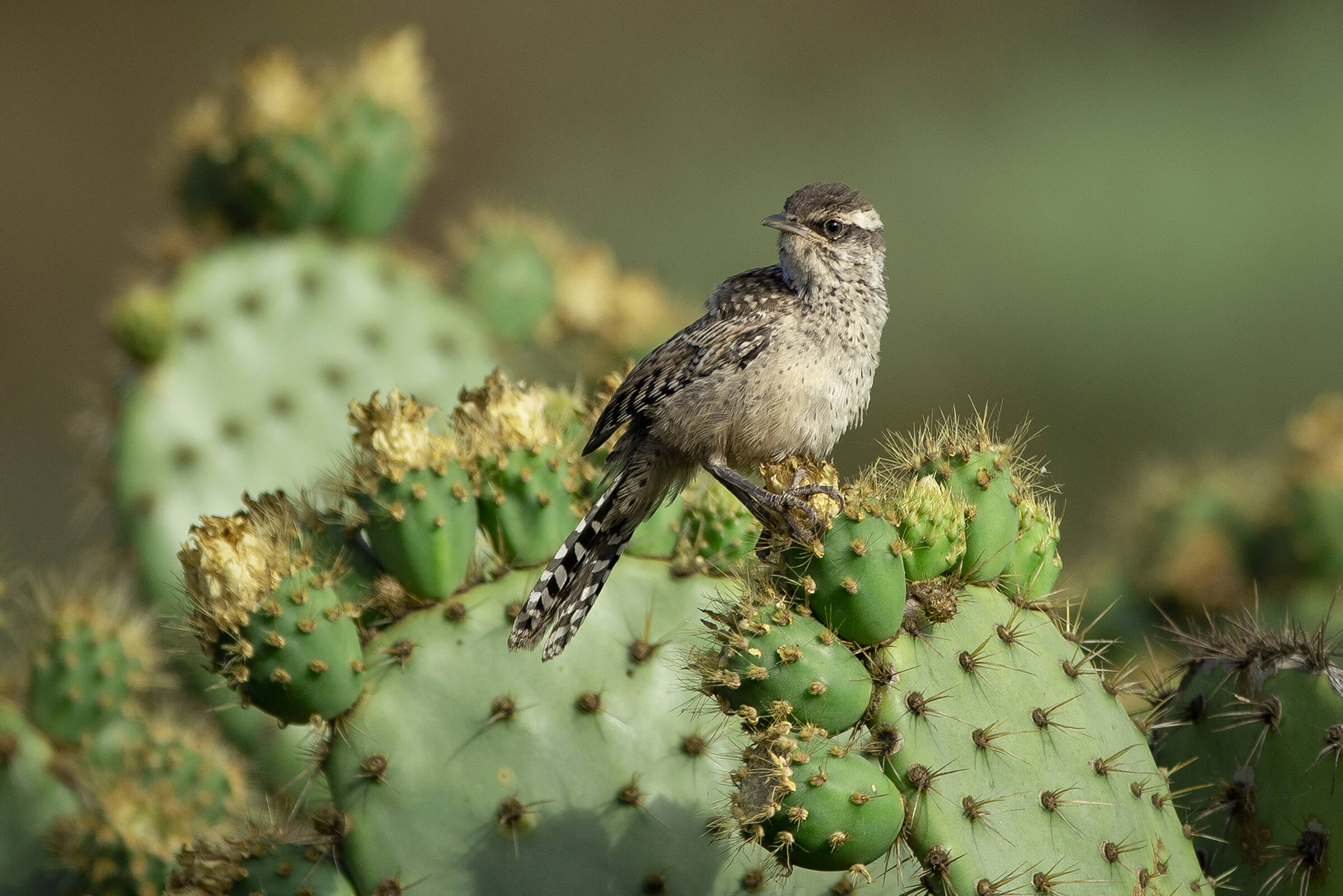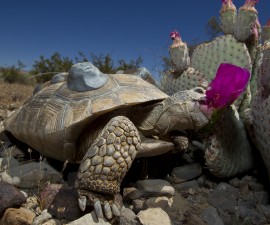BY Karyl Carmignani
Photography by Tammy Spratt
Sometimes, an adage variation holds true: replant it, and they will come. So it is at the undeveloped 800-acre Biodiversity Reserve adjacent to the Safari Park. This parcel of coastal sage scrub—one of the most threatened ecosystems in the US—is home to a broad range of native plants and animals, like the orange-throated whiptail lizard, coast patch-nosed snake, the rare flowering plant Campo clarkia, and the coastal cactus wren. The coastal cactus wren is unique and distinct from the cactus wren of Arizona and the Anza Borrego Desert, with different natural history and nesting requirements. “The cactus wren seems to be less picky than the coastal cactus wren,” explained Lisa Nordstrom, Ph.D., associate director, Recovery Ecology, San Diego Zoo Global (SDZG). “Coastal cactus wrens nest almost exclusively in prickly pear and cholla cactus, at least one meter [3.2 feet] tall.” In 2007, the Witch Creek fire swept through the Biodiversity Reserve, destroying much of the coastal cactus wren habitat. In response, SDZG’s Plant Conservation team partnered with other agencies to resuscitate the ecosystem, and those efforts, at long last, are paying off.
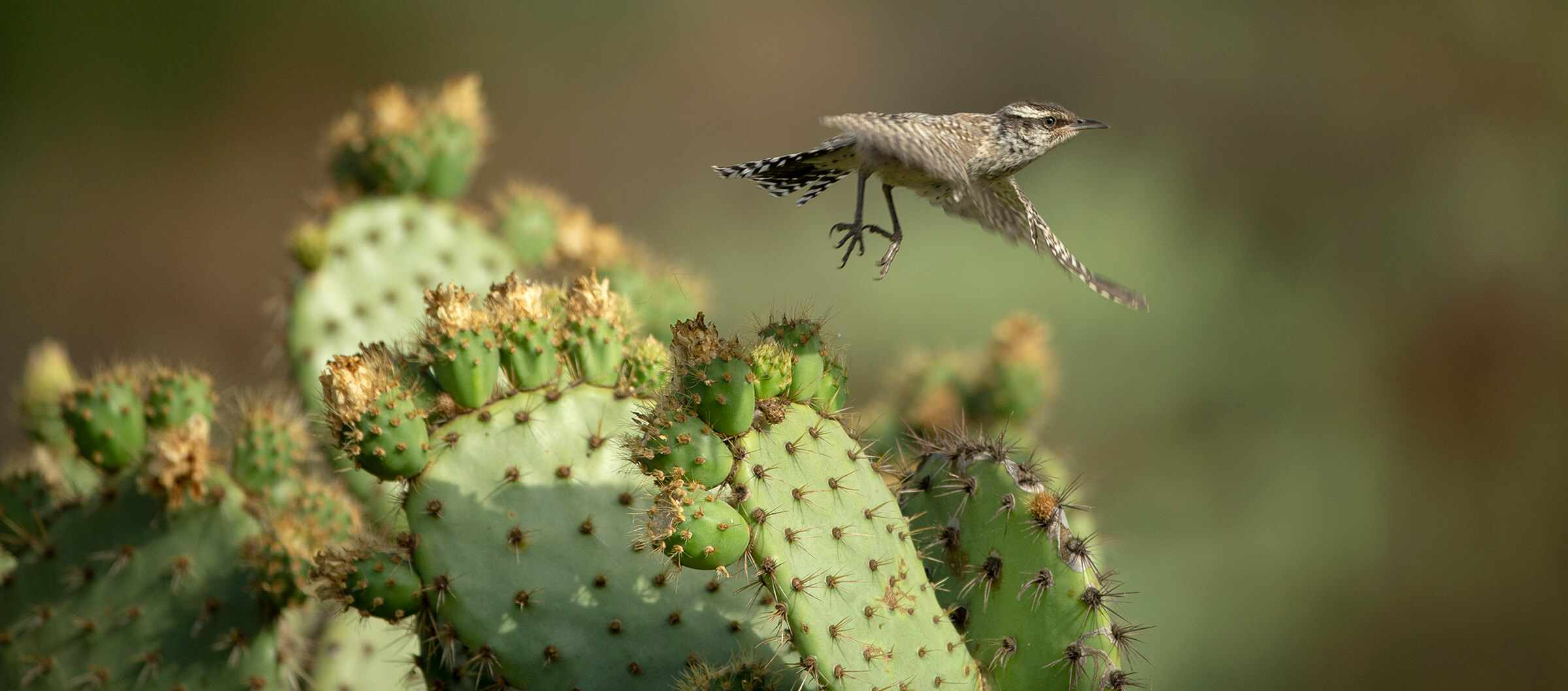
Replant, Restore, Reserve
Coastal cactus wrens Campylorhynchus brunneicapillus are about eight inches tall, with dark brown feathers sprinkled with white spots topside, a dappled cream-colored belly, a distinct snow-colored accent over each eye, and a long, pointed beak. From a perch atop spiny cactus, they swoop to the ground to nab insects and small reptiles. They are “chatty,” using a range of songs and calls to defend their space; one common territorial song sounds like an old-fashioned sewing machine or metered pecking on a manual typewriter. “But if you sit still for a while, you can hear their other calls,” said Charlie de la Rosa, Ph.D., SDZG natural lands program manager.
Though capable of flight, these songbirds manage compact territories of about 3.2 acres, rarely migrating. Lisa explained that they are highly specialized birds inhabiting fragmented habitat, so unless another suitable spot is nearby, they tend to stay put. However, it can be difficult for researchers to spot a banded bird and connect it to a distant patch of suitable habitat that they may have come from, so the birds may travel farther than we know. “We need more research to update our understanding,” she added. This year, against all odds, U.S. Geological Survey (USGS) biologists documented the longest known dispersal of a coastal cactus wren: a bird from Lake Jennings appeared at the Safari Park, making a whopping 16-mile trek. “It was a big ‘woohoo’ moment,” said Charlie. “It means they may be more resilient than we thought.” He said that some populations farther north can include fewer than 10 birds, so it would be beneficial to their genetics if they can disperse across the landscape.
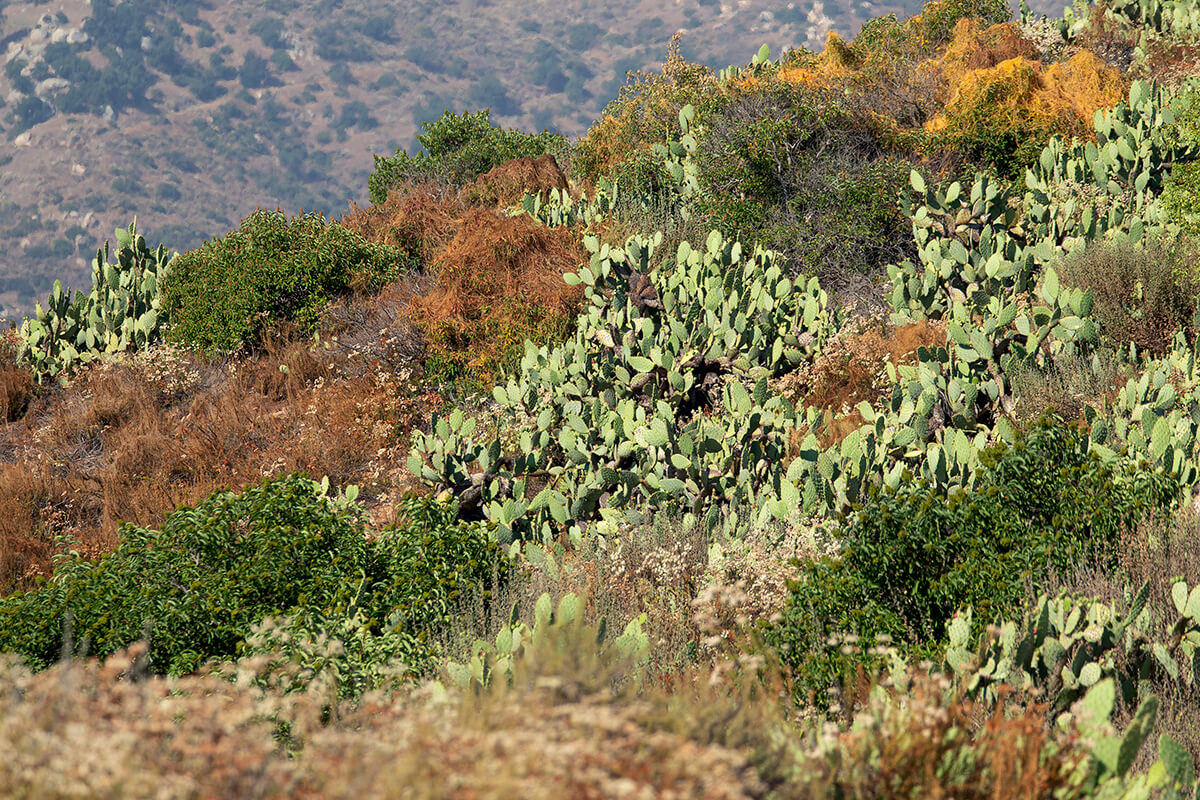
COASTAL SAGE SCRUB
This threatened habitat is a complex ecosystem, home to many endemic and native species, including the coastal cactus wren.
The scarcity of uninterrupted coastal sage scrub leaves the ecosystem vulnerable to wildfire, drought, invasive nonnative plants, and human development. After the devastating 2007 Witch Creek fire ravaged the San Pasqual Valley, including acres of prickly pear cactus, SDZG’s Plant Conservation team partnered with other organizations to launch a large-scale habitat restoration. Coastal cactus wrens build domed, oblong nests tucked inside prickly pear cactus, which protects their altricial, nidicolous (youngsters that stay at the nest even after they are able to leave) offspring from predators. When youngsters finally do leave the nest, they travel only a mile or two to stake out their own territory. But without suitable nesting areas replete with prickly pear and cholla cactus, the population could blink out. So, a labor-intensive project was crafted, which included headstarting prickly pear cactus pads in a nursery and planting them throughout the Biodiversity Reserve. “About 11,000 cactuses were propagated for the restoration project between 2009 and 2011,” said Charlie. “Staff and volunteers planted—and hand-watered—around 250 cactuses per acre, over 45 acres, along with other native plants.” As the model predicted, it took seven years for the prickly pear to grow tall enough to shelter the coastal cactus wrens. Some planted cactuses have nests now! “Restoration takes time, and now we’re reaping the benefits.”
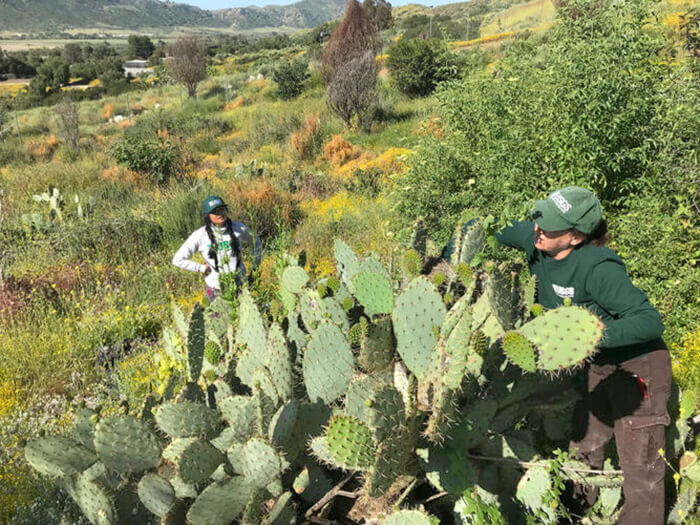
TO THE POINT
USGS biologist Lisa Allen doing “cactus yoga” to check on a coastal cactus wren nest. Photo by Charlie de la Rosa, SDZG.
Nonnative plants also pose a threat to the birds, as they can overgrow and cover the ground, leaving the birds nowhere to hunt. “Cactus scrub has open spaces, which the wrens use to see and hunt prey,” said Lisa. “Survival of chicks decreases with nonnative plant overgrowth.” Species like stinknet, a fast-growing, nonnative plant, can have a negative impact on the birds’ foraging and nesting opportunities, while also increasing the fire risk. Once again the team sprang into action, working with the American Conservation Experience to selectively apply herbicide to stinknet plants before they bloomed and spread this past spring. Habitat restoration takes the long view and requires patience, even as another fire season is upon us. “More gene flow and connectivity is what’s needed for the coastal cactus wren,” said Lisa. And this restored natural habitat will help!
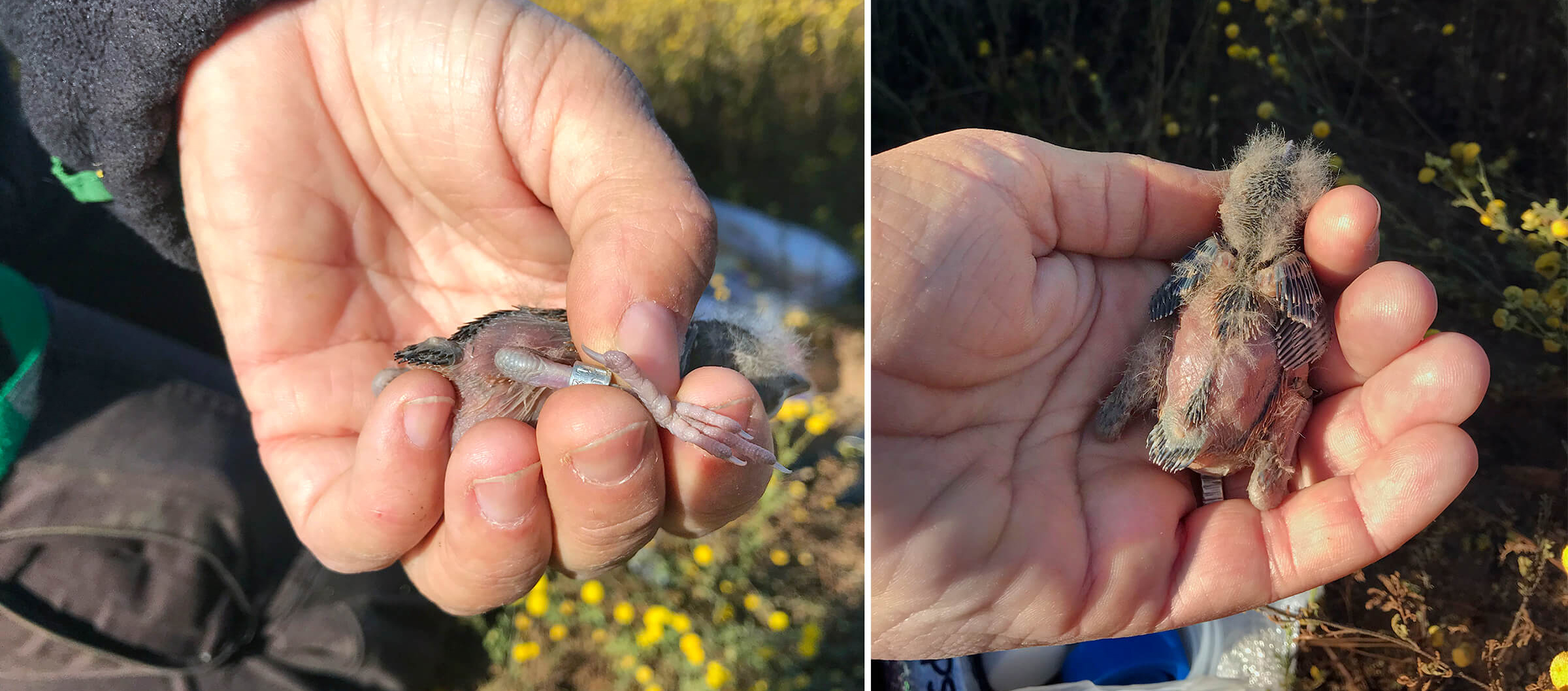
A Bird In the Hand…
Monitoring and banding the birds is important. But how does one monitor chicks in a dark nest behind a thorny “security wall” several feet off the ground? In a word: carefully. “You have to be a contortionist to reach past the cactus spines,” said Colleen Wisinski, conservation program specialist, SDZG. “We try to catch them and band them before they fly—about nine days old—so we don’t accidentally ‘force fledge’ them.” Our partners at USGS use a camera scope on an adjustable pole to peek into the nests, as the parent birds protest nearby.

HOME SWEET HOME
Coastal cactus wrens build their secure, football-shaped nests on prickly pear cactus, which deters most predators.
Another technique used to catch adult birds is setting up a mist net and playing the call of an intruder. When the adult arrives to fend off the interloper, it is gently caught in the net. Each bird gets a unique color combination of bands—its ID. The birds don’t outgrow their bands. “If it fits a juvenile, it will fit for life,” said Colleen. This past year, USGS has banded at least 16 chicks at the Biodiversity Reserve. With about 50 pairs of coastal cactus wrens, the reserve is home to one of the largest populations in San Diego County. “With all the urbanization of Southern California, it’s amazing that these birds could still be here,” said Colleen. “And yet they persist. But they still need our help.” Fortunately, there’s a dedicated team in the wings, ready to assist.
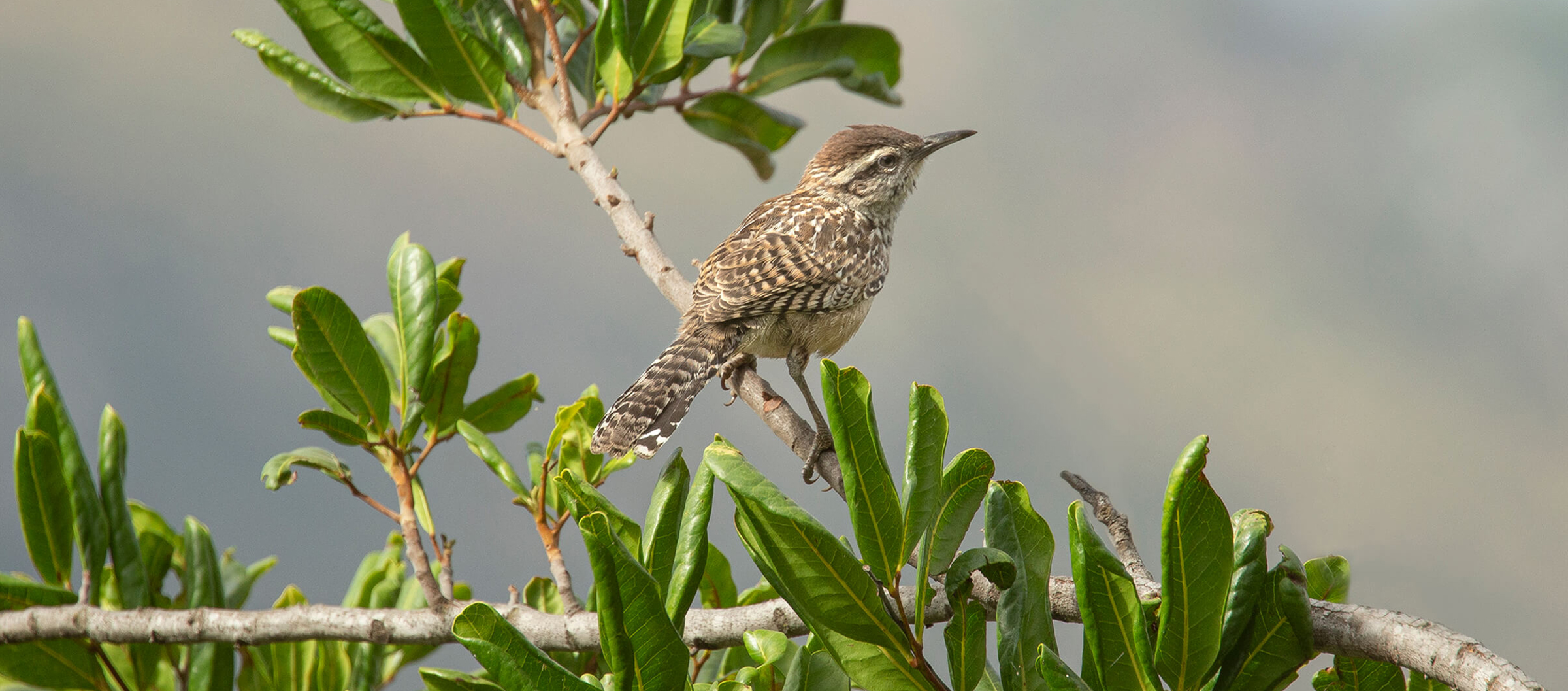
 The Family name for wrens is Troglodytidae, meaning “cave dweller.”
The Family name for wrens is Troglodytidae, meaning “cave dweller.”
It’s Complicated
In our rapidly changing world, plants and animals face an ever-increasing onslaught of challenges. Classifications of species, subspecies, unique populations, or genetically distinct populations is a complicated and oftentimes fluid endeavor. But the results of species’ classifications can impact state and federal listings and protections (and funding). For instance, cactus wrens taken as a whole may be somewhat numerous across their fragmented habitat, but isolated populations may become distinct species and require more rigorous conservation efforts. California recognizes the San Diego cactus wren as well as the coastal cactus wren, which is listed as a Species of Special Concern. But both taxonomic splitters and lumpers can agree that the cactus wren needs and deserves our care and habitat conservation.
According to Birds of North America, there are nine wren species in the US (eight of them have been seen in Canada, as well): canyon wren, Carolina wren, Bewick’s wren, house wren, marsh wren, rock wren, sedge wren, winter wren, and the cactus wren—the largest of the North American wrens.

